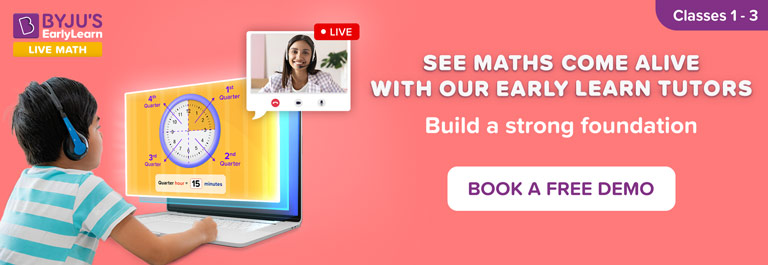Class 2 Maths covers topics that help students learn new concepts. It is important to understand that these new math concepts are foundation for the next topics in the higher classes. CBSE Class 2 Maths syllabus for the academic year 2023-2024 is prepared by the Board in such a way that students find it very effective and interesting to learn. Knowing the CBSE syllabus will help them to understand what they are going to study for that particular academic year.
CBSE Class 2 Maths Syllabus for 2023-24 Academic Year
To download the CBSE Syllabus for Class 2 Maths, click on the link below.
Download CBSE Class 2 Maths Syllabus PDF for 2023-24
2023-24 CBSE Class 2 Maths Syllabus
CBSE Class 2 students can download Maths syllabus for the academic year 2023-2024 given below.
Geometry (13 hrs.)
a) Shapes and Spatial Understanding 3-D and 2-D shapes
- Observes objects in the environment and get a qualitative feel for their geometrical attributes.
- Identifies the basic 3-D shapes such as cuboid, cylinder, cone, and sphere by their names.
- Traces the 2-D outlines of 3-D objects.
- Observes and identify these 2-D shapes.
- Identifies 2-D shapes viz., rectangle, square, triangle, and circle by their names.
- Describes intuitively the properties of these 2-D shapes.
- Identifies and makes straight lines by folding, straight-edged objects, and stretched strings and draws freehand and with a ruler.
- Draws horizontal, vertical and slant lines (freehand).
- Distinguishes between straight and curved lines.
- Identifies objects by observing their shadows.
Numbers (46 hrs.)
- Reads and writes numerals for numbers up to ninety-nine.
- Expands a number with respect to place values.
- Counts and regroups objects into tens and ones.
- Uses the concept of place value in the comparison of numbers.
- Counts in various ways:
– Starting from any number.
– Group counting etc. - Arranges numbers up to a hundred in ascending and descending order.
- Forms the greatest and the smallest two-digit numbers with and without repetition of given digits.
- Indicates and identifies the position of an object in a line.
a) Addition and Subtraction
- Adds and subtracts two-digit numbers by drawing representations of tens and ones without and with regrouping.
- Adds zero to a number and subtracts zero from a number.
- Observes the commutative property of addition through patterns.
- Solves addition, and subtraction problems presented through pictures and verbal description.
- Describes orally the situations that correspond to the given addition and subtraction facts.
- Estimates the result of addition and subtraction and compares the result with another given number.
b) Preparation for Multiplication And Division
- Discussion of situations involving repeated addition and situations involving equal sharing.
- Activities of making equal groups.
c) Mental Arithmetic
- Adds and subtracts single-digit numbers mentally.
- Adds and subtracts multiples of ten mentally.
Money (3 hrs.)
- Identifies currency – notes and coins.
- Puts together amounts of money not exceeding Rs 50/-.
- Adds and subtracts small amounts of money mentally.
- Transacts an amount using 3-4 notes.
Measurement (13 hrs.)
a) Length
- Measures lengths & distances along short & long paths using uniform (non-standard) units, and extends to longer lengths.
b) Weight
- Compares two or more objects by their weight.
- Appreciates the need for a simple balance.
- Compares weights of given objects using simple balance.
c) Capacity (Volume)
- Compares and orders containers in terms of internal volume(capacity).
- Orders given containers as per their capacities on the basis of perception & verifies by pouring out etc.
d) Time
- Gets familiar with the days of the week and months of the year.
- Gets a feel for the sequence of seasons (varying locally).
- Sequences the events occurring over longer periods in terms of dates/days.
Data Handling (6 hrs.)
- Collects data through measurement.
- Represents the data followed by discussion (e.g. heights of children).
- Collects and presents the data on birthdays.
- Draws inferences from the data at the appropriate level.
Patterns (10 hrs.)
- Observes and extend patterns in the sequence of shapes and numbers.
- Searches for patterns in different ways of splitting a number.
- Creates block patterns by stamping thumbprints, leaf prints, vegetable prints, etc.
- Creates patterns of regular shapes by stamping.
CBSE Class 2 Maths Syllabus Chapter List
Get the latest syllabus of CBSE Class 2 Maths for the academic year 2023-2024. The CBSE Syllabus for Class 2 Maths covers the following topics.
Chapter 1: What is Long, What is Round?
Chapter 2: Counting in Groups
Chapter 3: How Much Can You Carry?
Chapter 4: Counting in Tens
Chapter 5: Patterns
Chapter 6: Footprints
Chapter 7: Jugs and Mugs
Chapter 8: Tens and Ones
Chapter 9: My Funday
Chapter 10: Add Our Points
Chapter 11: Lines and Lines
Chapter 12: Give and Take
Chapter 13: The Longest Step
Chapter 14: Birds Come, Birds Go
Chapter 15: How Many Ponytails
Learn Maths & Science in an interactive & fun-loving way with BYJU’S App/Tablet.

Please share CBSE syllabus of class 2
https://byjus.com/cbse-class-2-syllabus/
I would like to get info for Grade 2
I want class 2 chapters pdf